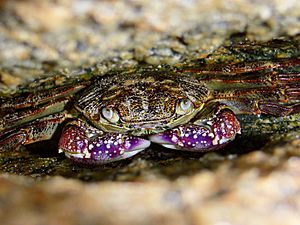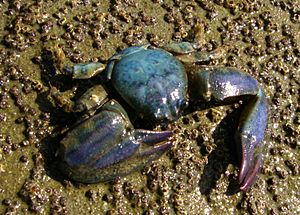List of crabs of New Zealand facts for kids
In the waters around New Zealand, you can find many amazing creatures, including 77 different kinds of living crabs! There are also 10 species that are "crab-like" but belong to a group called Anomura. Imagine, we even have records of 24 types of crabs that lived long, long ago – these are called fossils.
Many of these crabs are special because they are endemic to New Zealand. This means they are found naturally nowhere else in the world! We'll mark these unique crabs in bold letters. The fossil crabs will have a little dagger symbol (†) next to their names.
Most of these crabs live in the ocean, but there's one special freshwater crab called Amarinus lacustris. Scientists are always discovering more, and a recent list shows there are now 167 known species of true crabs (Brachyura) and over 50 crab-like Anomura in New Zealand!
True Crabs: The Brachyura Group
The Brachyura are what we usually think of as "true crabs." They have a short, tucked-under tail and a wide, flat body. This group includes many different families of crabs.
Dromiidae Family
These are often called sponge crabs because some species carry sponges on their backs for camouflage.
- Petalomera wilsoni (Fulton & Grant, 1902)
Homolidae Family
Homolid crabs are sometimes called "carrier crabs" because they can carry objects like sponges or anemones on their last pair of legs.
- Dagnaudus petterdi (Grant, 1905)
- Homola orientalis Henderson, 1888
- Yaldwynopsis spinimanus (Griffin, 1965)
Latreilliidae Family
These are often very slender, long-legged crabs.
- Eplumula australiensis (Henderson, 1888)
Raninidae Family
Raninid crabs are also known as "frog crabs" because of their unique body shape, which is often oval or pear-shaped.
- Hemioon novozelandicum Glaessner, 1980 †
- Laeviranina perarmata Glaessner, 1960 †
- Lyreidus elegans Glaessner, 1960 †
- Lyreidus tridentatus De Haan 1841
- Lyreidus waitakiensis Glaessner, 1980 †
- Ranilia pororariensis Glaessner, 1980 †
Cymonomidae Family
These are deep-sea crabs, often with unusual shapes.
- Cymonomus aequilonius Dell, 1971
- Cymonomus bathamae Dell, 1971
Torynommidae Family
This family includes some ancient fossil crabs.
- Torynomma flemingi Glaessner, 1980 †
Heterotremata Group
This is a very large and diverse group of true crabs, including many common types you might see.
- Leucosiidae
- Ebalia laevis (Bell, 1855)
- Merocryptus lambriformis A. Milne-Edwards, 1873
- Tanaoa pustulosus (Wood-Mason in Wood-Mason & Alcock, 1891)
- Majidae
- Eurynolambrus australis H. Milne-Edwards & Lucas, 1841
- Eurynome bituberculata Griffin, 1964
- Jacquinotia edwardsi (Jacquinot, 1853)
- Leptomithrax atavus Glaessner, 1960 †
- Leptomithrax australis (Jacquinot in Jacquinot & Lucas, 1853)
- Leptomithrax garricki Griffin, 1966
- Leptomithrax irirangi Glaessner, 1960 †
- Leptomithrax longimanus Miers, 1876
- Leptomithrax longipes (Thomson, 1902)
- Leptomithrax tuberculatus Whitelegge, 1900
- Leptomithrax uruti Glaessner, 1960 †
- Notomithrax minor (Filhol, 1885)
- Notomithrax peronii (H. Milne-Edwards, 1834)
- Notomithrax ursus (Herbst, 1788)
- Prismatopus filholi (A. Milne-Edwards, 1876)
- Teratomaia richardsoni (Dell, 1960)
- Inachidae
- Achaeus curvirostris (A. Milne-Edwards, 1873)
- Cyrtomaia lamellata Rathbun, 1906
- Dorhynchus ramusculus (Baker, 1906)
- Platymaia maoria Dell, 1963
- Platymaia n.sp.
- Trichoplatus huttoni A. Milne-Edwards, 1876
- Inachoididae
- Pyromaia tuberculata (Lockington, 1877)
- Epialtidae
- Actinotocarcinus chidgeyi Jenkins, 1974 †
- Rochinia riversandersoni (Alcock, 1895)
- Leptomaia tuberculata Griffin & Tranter, 1986
- Atelecyclidae
- Pteropeltarion novaezelandiae Dell, 1972
- Trichopeltarion fantasticum Richardson & Dell, 1964
- Trichopeltarion greggi Dell, 1969 †
- Cancridae
- Metacarcinus novaezelandiae (Hombron & Jacquinot, 1846)
- Tumidocarcinidae
- Tumidocarcinus dentatus Glaessner, 1960 †
- Tumidocarcinus giganteus Glaessner, 1960 †
- Tumidocarcinus tumidus (Woodward, 1876) †
- Dorippidae
- ?Eodorippe spedeni Glaessner, 1980 †
- Pororaria eocenica Glaessner, 1980 †
- Ovalipes catharus (White in White & Doubleday, 1843)
- Ovalipes molleri (Ward, 1933)
- Ovalipes sp A. Glaessner, 1960 †
- Portunus pelagicus (Linnaeus, 1766)
- Liocarcinus corrugatus (Pennant, 1777)
- Nectocarcinus antarcticus (Hombron & Jacquinot, 1846)
- Nectocarcinus bennetti Takeda & Miyake, 1969
- Rhachiosoma granulifera (Glaessrier, 1960) †
- Scylla serrata (Forskal, 1775)
- Menippidae
- Menippe sp. Glaessner, 1960 †
- Pseudocarcinus sp. Glaessner, 1960 †
- Oziidae
- Ozius truncatus H. Milne-Edwards, 1834
- Pilumnidae
- Pilumnopeus serratifrons (Kinahan, 1856)
- Pilumnus lumpinus Bennett, 1964
- Pilumnus novaezelandiae Filhol, 1886
- Belliidae
- Heterozius rotundifrons A. Milne-Edwards 1867
- Goneplacidae
- Carcinoplax victoriensis Rathbun, 1923
- Goneplax arenicola (Glaessner, 1960) †
- Neommatocarcinus huttoni (Filhol, 1886)
- Galenidae
- Galene proavita Glaessner, 1960 †
Thoracotremata Group

This group includes many familiar shore crabs and mud crabs.
- Grapsidae
- Austrohelice crassa (Dana, 1851)
- Leptograpsus variegatus (Fabricius, 1793)
- Miograpsus papaka Fleming, 1981 †
- Planes cyaneus Dana, 1852
- Planes marinus Rathbun, 1914
- Plagusiidae
- Plagusia chabrus (Linnaeus, 1758)
- Plagusia squamosa (Herbst, 1790)
- Varunidae
- Hemigrapsus crenulatus (H. Milne-Edwards, 1837)
- Hemigrapsus sexdentatus (H. Milne-Edwards, 1837)
- Cyclograpsus insularum Campbell & Griffin, 1966
- Cyclograpsus lavauxi H. Milne-Edwards, 1853
- Pinnotheridae
- Pinnotheres atrinicola Page, 1983
- Pinnotheres novaezelandiae Filhol, 1886
- Ocypodidae
- Macrophthalmus hirtipes (Jacquinot in Hombron & Jacquinot, 1846)
- ?Macrophthalmus major (Glaessner, 1960) †
- Hymenosomatidae
- Amarinus lacustris (Chilton, 1882)
- Elamena longirostris Filhol, 1885
- Elamena momona Melrose, 1975
- Elamena producta Kirk, 1878
- Halicarcinus cookii (Filhol, 1885)
- Halicarcinus innominatus Richardson, 1949
- Halicarcinus ovatus Stimpson, 1858
- Halicarcinus planatus (Fabricius, 1775)
- Halicarcinus tongi Melrose, 1975
- Halicarcinus varius (Dana, 1851)
- Halicarcinus whitei (Miers, 1876)
- Halimena aotearoa Melrose, 1975
- Hymenosoma depressum Jacquinot, 1853
- Neohymenicus pubescens (Dana, 1851)
Crab-like Creatures: The Anomura Group
The Anomura are a group of crustaceans that look a lot like true crabs, but they have some key differences. For example, their last pair of legs is often very small and tucked away. This group includes hermit crabs and porcelain crabs.
Lithodidae Family (King Crabs)
These are often large, spiny crabs found in cold, deep waters.
- Lithodes aotearoa Ahyong, 2010
- Lithodes jessica Ahyong, 2010
- Lithodes macquaria Ahyong, 2010
- Lithodes robertsoni Ahyong, 2010
- Neolithodes brodiei Dawson & Yaldwyn, 1970
- Neolithodes bronwynae Ahyong, 2010
- Paralomis dawsoni Macpherson, 2001
- Paralomis debodeorum Feldman, 1998 †
- Paralomis echidna Ahyong, 2010
- Paralomis hirtella Saint Laurent & Macpherson, 1997
- Paralomis poorei Ahyong, 2010
- Paralomis staplesi Ahyong, 2010
- Paralomis webberi Ahyong, 2010
- Paralomis zealandica Dawson & Yaldwyn, 1971
Paguridae Family (Hermit Crabs)
Hermit crabs are famous for living in empty snail shells to protect their soft bodies.
- Porcellanopagurus edwardsi Filhol, 1885
Porcellanidae Family (Porcelain Crabs)
These crabs are often small and flat, and they can lose their limbs easily, like porcelain breaking.
- Petrolisthes elongatus (H. Milne-Edwards, 1837)
- Petrolisthes novaezelandiae Flihol, 1886
- Petrocheles spinosus Miers, 1876
See also



